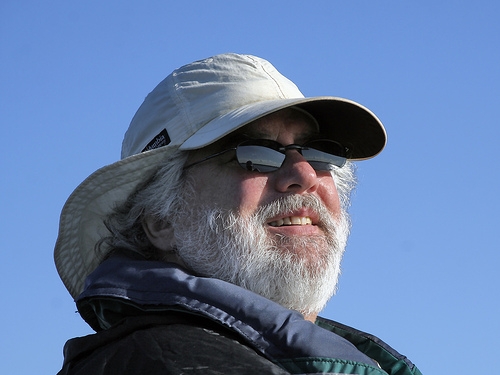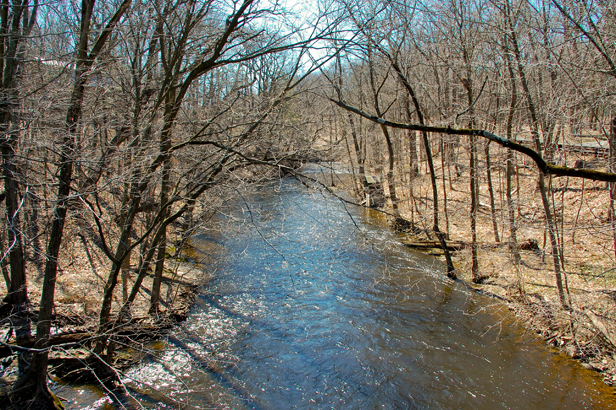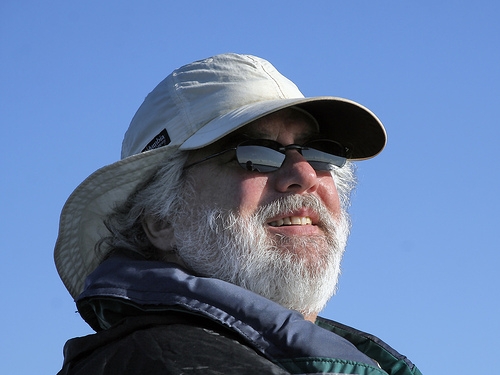 Andy Willner, activist and advocate of the Passaic.Photo courtesy of al-ICE g via FlickrOn Jan. 2, 1990, a leaking pipeline at Bayonne, New Jersey’s Exxon Bayway oil refinery sent 567,000 gallons of heating fuel into the surrounding waterways and marsh. Andy Willner volunteered to help the affected wildlife. He wound up collecting a truckload of dead Canvasback ducks and driving them straight to the refinery. When a worker there tried to shoo him away, Willner threatened to drive the oily carcasses across the Hudson to the door of The New York Times. The worker acquiesced. An activist was born.
Andy Willner, activist and advocate of the Passaic.Photo courtesy of al-ICE g via FlickrOn Jan. 2, 1990, a leaking pipeline at Bayonne, New Jersey’s Exxon Bayway oil refinery sent 567,000 gallons of heating fuel into the surrounding waterways and marsh. Andy Willner volunteered to help the affected wildlife. He wound up collecting a truckload of dead Canvasback ducks and driving them straight to the refinery. When a worker there tried to shoo him away, Willner threatened to drive the oily carcasses across the Hudson to the door of The New York Times. The worker acquiesced. An activist was born.
Not long after the Bayway spill Willner became the Executive Director of the N.Y./N.J. Baykeeper organization, the so-called “citizen guardian of Hudson-Raritan estuary … the most urban estuary on Earth.” The Passaic River is part of that estuarine system, and Willner has been one of the Passaic’s most vocal advocates. Willner retired in 2009. But in 20-plus years as head of Baykeeper, he spent countless hours patrolling and pleading for the Lower Passaic. The final 17-mile stretch, from the Dundee Dam in Garfield, N.J. to the river’s mouth in Newark, is home to the Diamond Alkali Superfund site, the oldest unresolved superfund site in the country. This last reach of river cuts through the most crowded and heavily industrialized part of the country, and the river has the scars to prove it. Willner has done more than anyone to call attention to those scars and to the people most responsible for inflicting them.
Q. How did you first get involved with the Passaic River?
A. The Passaic is one of the tributaries to New York Harbor. So when I first started the N.Y./N.J. Baykeeper organization back in the early 1990s, we took a hard look at the Passaic. It didn’t seem like there were people either paying attention to the Lower Passaic or doing anything on the water. For a long time neither the federal Environmental Protection Agency — which is in charge of Superfund and the Passaic, unfortunately, is a Superfund area — nor the New Jersey Department of Environmental Protection was really doing very much about cleaning up the river. So the Passaic became a priority very early on.
Q. What did Baykeeper actually do about the Passaic?
A. Seeing as there was no one looking after the Passaic we took the challenge. And it became a very unique challenge. Here was a river that most people had forgotten. We had to build a river advocacy organization from scratch.
We formed a unique partnership with the Hackensack Riverkeeper and started having Passaic River patrols and canoe trips, all as a way to get people more aware, and to bring the river into focus for the institutions, for government agencies, for organizations that advocated for other rivers but not the Passaic, and for the citizens who lived along the river’s banks.
We also had to get the government agencies aware that there was a huge problem and a big constituency that wanted to see the problem fixed. So we started taking government officials out on the river.
And very early on we became advocates for making the polluter — which has evolved into a company called Occidental Chemical — be the one who pays for both the cleanup and for the natural resource restoration of the Passaic.
Q. What did these Passaic River patrols do?
A. Let me start by saying that Baykeeper and other water keepers around the world are unique in that part of their mission is to be advocates for a particular water body. Our Baykeeper organization is an advocate for the bays and tributaries to New York Harbor.
So a patrol is a way of observing from the water and making note of anomalies, taking photographs, recording the latitude and longitude of a pipe that something smelly is coming out of, looking for nefarious activities, and also documenting the inherent beauty. It’s a way to familiarize the organization’s staff and members with a place. It’s also a way to either assist government in prosecuting polluters by gathering evidence for that prosecution, or if the government is unwilling or unable to do that prosecution ourselves.
Q. How did river conditions change — for better or worse — in your 20 years with Baykeeper?
A. We see somewhat less debris floating in the river than we did when we first started patrolling. But I don’t think things have changed significantly in terms of the legacy pollutants, the dioxin, and heavy metals. I’d say the biggest change has been the attitude of the people who live along the river. There are, all of a sudden, boating advocacy groups on the Passaic, people canoeing and kayaking regularly, even in the most industrial part of the river. There have always been competitive rowing groups and high schools with rowing programs — and now they’ve become more popular. What’s happened is the river hasn’t changed very much but peoples’ attitudes towards it have started to change and that’s driving the government agencies to begin to make a change at the responsible party’s — Occidental Chemical’s — expense.
Q. I’ve heard you mention Moby Dick in the context of the Passaic. I wonder if you could explain why that classic novel about the hunt for a white whale is relevant?
A. It’s relevant for anybody who lives anywhere near the water. I won’t be able to quote this. But the first chapter is all about Manhattan. It talks about how people who live, particularly in port cities, move inevitably towards the water. Some go there to fish, some to look at the ships, some to just be in the salt air, but sometimes for no particularly obvious reason other than they’re drawn to the water. And that’s probably as true about the Passaic as it is about any tidal river in the world.
 The Passaic River, one of the most polluted rivers in the nation and a Superfund area.
The Passaic River, one of the most polluted rivers in the nation and a Superfund area.
Q. Even despite its present condition?
A. Yeah, you know, it’s not the river’s fault. It’s certainly not the fault of the people who are compelled to be near it. It’s really the fault of the polluters and the government agencies that have failed to fix the problems.
Q. Let’s talk about that, particularly in light of the failure of BP and of federal oversight that led to the massive Gulf oil spill. I realize that you’ve been retired for more than a year, but can you talk about the current status of the Passaic River cleanup?
A. There is now just the inkling of the beginning of a process that will have some pilot projects removing [dioxin-contaminated] sediments from the hottest spots in the river and monitoring whether there’s any re-suspension of contaminants as a result of that removal. At the same time – and this is one of the things that Baykeeper has advocated for for close to 20 years — the natural resource damages that occurred as a result of this pollution will be assessed and restoration projects will occur at the same time the cleanup is occurring. Whether that’s marsh restoration or shoreline restoration or public walkways and boat launches, all that stuff will start happening, and has already started to happen, along with the cleanup.
It became obvious that you can’t just keep people away from that river for another generation. That you had to do the remediation and the restoration and the restoration of public access all at the same time. It’s an innovative approach.
I’m not sure you can compare the kind of legacy pollutants we have from a stubborn polluter [Occidental Chemical] to the extraordinary disaster that’s happening in the Gulf, but I think there are some parallels:
One of the things that all major corporations who pollute do is try to diminish their individual liability. BP lied about how much oil was being discharged into the Gulf; Occidental tried to distance itself from the dioxin in the river.
When BP was shone for sure that there was more oil than they said there was, they said, well, it’s a big ocean. When Occidental was confronted with irrevocable proof that [the dioxin in the Passaic] was their dioxin, they said, well, it’s like a teaspoonful in a swimming pool. And so on, and so forth.
And the more time corporations can spend, and the more money they can spend on lawyers and public relations firms, the longer it will take. It took [Exxon] 25 years and five times in the Supreme Court, but they got the original $5 billion [Exxon Valdez] liability case against them reduced to $500 million dollars. That’s really what big companies do best, they stall and stall and stall until some government agency with guts or an organization like Baykeeper just stands up to them and says you’ve got to start cleaning up now and if you don’t we’ll do everything within our power to make sure you do.
Q. What advice would you give someone who’s concerned about their local urban river?
A. Don’t give up. Be aware that if you take on a project to bring an urban river back you’re not talking about six months or a year or even two years. You should be willing to spend a decade or two.
And you have to be at it all the time, and you have to engage people who live along the river’s banks, and you have to tell the truth, and you have to expose the inability or unwillingness of government to do anything, and you have to go right after the entity that polluted, and name names, and continue to do that over and over and over again until people start to say, “Oh yeah, it is them and they’re the ones who have to pay to clean it up”
And you have to get to love that river, as tough as some of these rivers are to love. You really have to get to love it, have it in your being, or else you won’t be an effective advocate.



